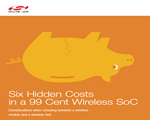Designing with Wireless Modules or Wireless SoC's - What are the costs?
Follow articleHow do you feel about this article? Help us to provide better content for you.
Thank you! Your feedback has been received.
There was a problem submitting your feedback, please try again later.
What do you think of this article?
In today’s product development environment, almost all devices require connectivity of sorts. More and more, these are wireless using a variety of standard protocols such as Bluetooth, ZigBee, Thread and WiFi as well as proprietary solutions. Implementing these solutions can be daunting to the engineer due to the many engineering challenges that RF design presents.
There are many decisions that need to be made regarding the wireless solution based on cost, distance, bandwidth, size, and standards, to name a few. Once these have been resolved, all the designer needs to do is build it. Not so simple! It turns out that quite a few skills and resources are needed to deliver quality solutions. Fortunately, engineers have options, particularly in the form of modules or SoC (System on a Chip) solutions. There are tradeoffs to be considered.
In most cases, a SoC based design can be cost optimized, size optimized and configured to the specific needs of the end product. Conversely, a module approach is likely easier to implement, pre-certified and less resource intensive. Only you can decide which might be better based on your needs, but here are six considerations and incremental costs to be considered:
- RF Engineers. This is a required skill for a SoC design. Good RF engineers are in demand and can be costly. Modules are self-contained, typically with an antenna so there is much less engineering involved.
- Lab Equipment. Extensive RF analysis and testing is required and uses very specialized equipment such as spectrum analyzers, anechoic chambers, calibrated gain horns, standards sniffers, etc. Cost to own is high as can be renting equipment or test facilities. Modules manufactures have done much of these work.
- PCB Layout and Antenna design. This can be very complex for SoC designs possibly requiring multiple test/revision cycles. Module manufacturers have done this already.
- Regulatory and Certification. Wireless products have to pass stringent emissions tests and can vary globally. Certification testing is also required to insure interoperability. All of these have associated costs. Modules typically have been through this and can pass forward their test results.
- Time to Market. This is key. The less wireless experience in the above areas one has, the more likely market windows can be missed.
- Supply Chain. A module is a single item to purchase where SoC based designs do require external components. There can be advantages by leveraging a module manufacture economy of scale, though likely the bill of material cost for an SoC solution will be less
Silicon Labs offers a cost analysis using these considerations that you can review in the attached white paper: Six Hidden Costs in a 99 Cent Wireless SoC. In our analysis, the breakeven can be between 100k and 200k units. But as they say, your mileage may vary.

For example, we offer Bluetooth solutions with our EFR32BG Blue Gecko SoC or our BGM111 or BGM113 Bluetooth modules.


